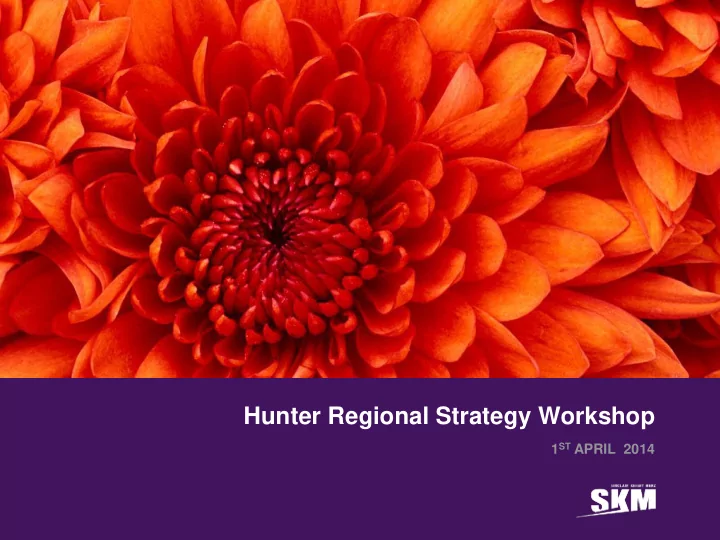

Hunter Regional Strategy Workshop 1 ST APRIL 2014
Agenda 9:00 Recap progress to date 9:15 Option evaluation • incl modelling outcomes • Recommendations 10:30 Baseline 11:30 Vision, themes, objectives and targets. 12:30 Next steps
Approach 1. Baseline position – Interviews – summary 2. Options Appraisal – Baseline Assessment – Define and model options – Score / Assess options – Identify preferred strategic approach 3. Data Strategy – Interviews – Assessment / Discussion – Data Strategy Document and Protocols 4. Waste Strategy
Approach 1. Baseline position – Interviews – Summary 2. Options Appraisal – Baseline Assessment – Define and model options – Score / Assess options – Identify preferred strategic approach 3. Data Strategy – Interviews – Assessment / Discussion – Data Strategy Document and Protocols 4. Waste Strategy
Options Appraisal
Evaluation approach • Evaluation framework • Quantitative analysis – cost, waste flows, performance • Qualitative – assessment criteria • Develop Scenarios • Discussion on framework • Debate/revise SKM’s initial evaluation
Evaluation framework – qualitative criteria • Performance • Diversion from landfill • Recycling rate • Cost • Collection • Treatment/Disposal • Implementation • Compatibility with existing systems • Perception of stakeholders • Technical deliverability • Market risk • Involves all councils/supports partnership
Evaluation framework – qualitative criteria • Performance • Diversion from landfill (modelled) • Recycling rate (modelled) • Cost • Collection (modelled) • Treatment/Disposal (modelled) • Implementation • Compatibility with existing systems • Perception of stakeholders • Technical deliverability • Market risk • Involves all councils/supports partnership
Option development/modelling Defined problem and solutions required • Collect data • Review of data – establish baseline position • Defined group of scenarios to help identify solution • Model variant scenarios • Built 3 models that work together – GIS spatial modelling (to understand logistic cost and facility location) – Waste flow (to determine performance and flows) – Basic cost modelling (to determine cost)
Option development/modelling Defined problem and solutions required • Collect data • Review of data – establish baseline position • Defined group of scenarios to help identify solution • Model variant scenarios • Built 3 models that work together – GIS spatial modelling (to understand logistic cost and facility location) – Waste flow (to determine performance and flows) – Basic cost modelling (to determine cost)
Scenario components Staged approach: 1. What happens at collection 2. What happens for bulking and transport 3. End treatment 4. Also consideration of waste prevention
Scenarios Modelled • Status Quo (benchmark / baseline to compare against) • Maximise performance of status quo, focus on increased capture of recyclables kerbside/self haul • Constrained residual container capacity to drive improvement in recycling (residual bin 140l) • Organic waste collection/processing • Food waste treated through Anaerobic Digestion (AD) • Garden treated through windrow • Mixed food and garden treated through In Vessel Composting
Scenarios Modelled (2) • Biodrying MBT, based on Port Stephens facility • Waste Prevention – through increased campaigns • Regional Landfill – fully engineered landfill with gas extraction • Waste to energy (combined with option 5 mixed food and garden to comply with EfW policy). Gasification with pre-treatment
Recommend
More recommend